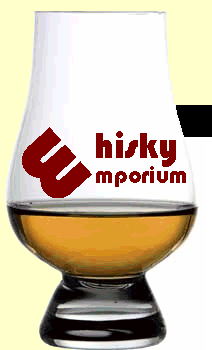| |
Hier können Sie mit mir
Verbindung aufnehmen, wenn Sie meine Dram-atics Artikel
kommentieren möchten. Ich werde so vielen Ihrer Einträge
antworten, wie nur möglich. |
|
| |
 |
|
Juli 2012
Spaß beiseite, jetzt wird gedrammt
"Juli ist mein „Geburtsmonat"
Ich bin wieder zuhause,
mein Besuch in Schottland mit seinen Märchenburgen ist jetzt
leider, leider bereits schon wieder Geschichte; der Juli
aber wird ein ganz besonderer Monat mit vielen großen Drams,
einigen vielleicht nicht so ganz großen Tropfen und auch
welchen irgendwo dazwischen.
Und, nun ja, es ist mein „Geburtsmonat“! |
|
| |
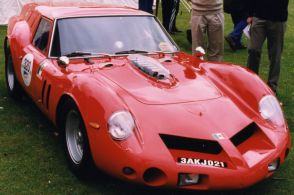 |
|
Saturday
July
7th
2012
True Classics
or "Motor
Maniac meets Malt Maniac"
After a recent discussion
about some wonderful old classics with fellow Malt Maniac
Serge, I decided what better way to celebrate a few
magnificent drams in my Birthmonth than to pair them with
some of those magnificent old classics.
|
|
| |
What would I
like for my Birthday? Well, a bread van like
this would be quite marvellous. It's a 1961 Ferrari 250 GT Drogo,
chassis No.2819GT.
In 1962 Count
Giovanni Volpi commissioned Giotto Bizzarrini to upgrade a
Ferrari 250 GT SWB to GTO specifications as Ferrari were not
amused with The Count and had refused to sell him a GTO. |
|
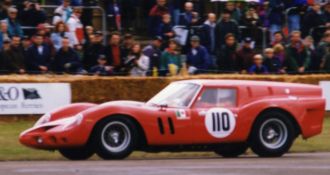 |
|
| |
Bizzarrini (auto
engineer) & Piero Drogo (a car body specialist) spent 14
days working on this project and in that short time created the
Ferrari 250 GT Drogo also known as the Bread Van
due to its unique shape. The Bread Van is lower than the GTO and
thanks to that shape, sees the engine further back in the middle
of the chassis. Thanks to a dry sump system the engine is also
lower than its GTO counterpart.
The Bread Van
competed in the 1962 Le Mans 24h and other world
championship events and reportedly had a 7 kmh faster straight
line speed than the GTO.
So, enjoy this
series which I will ehance over the next week or so, but
please remember, whisky and motors are both meant to enjoyed,
but never together. Don't drink and drive!
Slàinte Mhath
All photos
copyright Whisky Emporium photography and may not be copied or
re-used without permission. |
|
| |
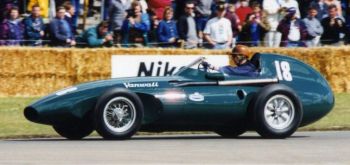 |
|
Glenfarclas 1966
Vanwall 1954-60 |
|
 |
|
| |
Vanwall competed in
Formula 1 during the 1950's
and
was founded by Tony Vanderwell, owner of Thinwall bearings in
Acton, London. The team name Vanwall was created by combining
the name of the owner with his business name, hence Vanwall.
Vanwall started by converting Ferraris for non-championship
races, but in 1954 they created their own car for that year's
Formula 1 season.
The team
achieved racing successes in 1957 & 58 with Stirling Moss
and Tony Brooks at the wheel. Sadly, Vanderwell's health was
deteriorating during this time and 1958 was the team's last full
racing season, even though they won the inaugural constructor's
championship that year. The team stopped racing in 1960.
Glenfarclas 1966
for Nth Las Vegas is a special bottling for the Universal
Whisky Experience, Las Vegas, March 18th & 19th 2011 and is one
of only 219 bottles. Cask No.2602 has matured this whisky for
well over 40 years and created a truly stunning nose offering
the fruitiness of plums and damsons, alongside aged oak and some
wonderful floral and herbal notes in the background. Although
the palate doesn't quite have the delicate beauty of the nose,
it is rich and full-flavoured with coffee, dark chocolate and
oil of orange.
Vanwall may not have survived to see this Glenfarclas created,
but for me these are two quintessentially British marques
deserving of full recognition as I begin my personal exploration
of Classic pairings for July. |
|
| |
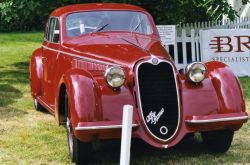 |
|
(Sunday July 8th)
BenRiach 1976 35y "Auld Alliance"
Alfa Romeo
6C
2300
Ca. 1938 |
|
 |
|
| |
Alfa Romeo is
undoubtedly one of the great auto marques
with a
racing pedigree dating back to its inception in 1910, when a
group of entrepreneurs took over the Darracq automobile company
on the outskirts of Milan.
They called
their new company
Anonima
Lombardia
Fabbrica
Automobili
and their racing successes date right back to 1913 when they
achieved 2nd place in the Parma-Poggio Berceto hillclimb. In
1914 they built their first grand prix car which covered a
kilometre at more than 147 km/h.
My featured car today is the
Alfa Romeo 6C 2300B Corto which has a straight 6 (cylinder)
2.3 litre engine with 95 BHP and capable of 81 mph (130 km/h).
It's a rather beautiful 2+2 fixed head coupé with all the
elegance of those late 1930's.
BenRiach 1976,
35y for Auld Alliance, Singapore is another special bottling,
this time for Auld Alliance in Singapore and is also a thing of
beauty and great surprises. From the very first nosing it
announces an incredibly fruity presence which is rich in
pineapple and pink grapefruit. The fruitiness extends to the
palate which now includes not only pineapple, but also banana,
raspberry, peach and some wonderfully creamy vanilla. The finish
just continues with more light fruitiness as this whisky just
goes on and on and ....
ALFA Romeo is one of my favourite auto marques with which the
general public seem to have a love or hate relationship. I
personally love them, in fact I currently own my second model
which offers endless driving pleasure so I didn't hesitate to
pair this wonderful 6C with an equally pleasurable BenRiach 1976
which I have awarded a mighty 88 points. As for the ALFA? At
least as many points, Si?
|
|
| |
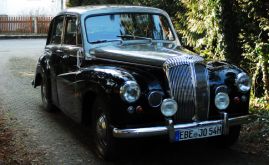 |
|
(Monday July
9th)
The Glenlivet "Josie"
Daimler Conquest
1953 |
|
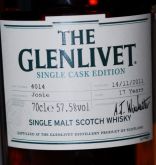 |
|
| |
The Daimler
Conquest
was
produced from 1953 to 1958 and was an executive luxury saloon
with a 2.4 litre straight 6 engine, 75 BHP, a top speed of 90
mph and 0-60 mph in 20.4 seconds. A total of 4568 of this saloon
model were produced. I'm pleased to say that this particular
example enjoys a working life here in Bavaria and is in
excellent condition. How do I know this? No, sadly I don't own
it, but it is pictured on my driveway as I hired it for my
wedding in 2008.
The Glenlivet "Josie"
is one of a range of annual alphabetic single cask releases from
the distillery and the name always reflects something particular
to the distillery. I have previously seen Faemussach and this
one; Josie is named after Glenlivet's underground spring. It
exhibits the typical fruity style of Glenlivet with plenty of
orange and lime, but it also includes fresh coffee beans on the
nose and cappuccino on the palate. It does have a little
woodiness, but not overpowering for my taste.
How can a series like this not include an original Daimler, it's
just so very English and with a nickname (thanks to the number
plate) of "Jo", it just had to be paired with Glenlivet's "Josie",
Aye,
87 points too although "jo" is probably worth a few more!
|
|
| |
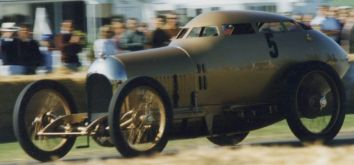 |
(Tuesday July
10th)
Mortlach 1942, 50y
Golden Submarine
1917 |
 |
|
| |
The Golden
Submarine
was
built in 1917 by Harry A Miller and Fred Offenhauser
specifically for Barney Oldfield. In fact this car is said to
have brought Miller nationwide prominence as a race-car builder.
It comprised an aluminium body, a 4.7 litre aluminium alloy
engine with 136 HP and on its racing debut in 1917 at the
Chicago Board Speedway, averaged 104 mph up to the point when
the engine failed. The car went on to compete in 54 races,
winning 20 and also with two second places and two third places.
G&M's 1942, 50y
Mortlach is from their Book of Kells series and offers many
of the typical Mortlach characteristics, but in a surprisingly
light way for such an aged whisky. It has the fruit of plums and
dark cherries alongside a woodiness on the nose and then a
palate offering that nuttiness alongside quite herbal elements.
The finish is again surprisingly delicate and gentle.
A Mortlach with such a provenance but yet surprisingly delicate
character has really found a soul-mate with the
Golden
Submarine
which is equally rare, delicate and surprising. I had the
pleasure of seeing this amazing machine running in the late 90's
at Goodwood Festival of Speed and it was one of the stars of the
show. Similarly, in June 2012 the Mortlach was one of the stars
of our Maniacal 15y Anniversary. I think 88 points for each is
very fair indeed.
|
|
| |
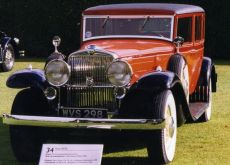 |
|
(Wednesday July
11th)
Convalmore "Rare Malts" 24y
Stutz DV32 1933 |
|
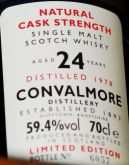 |
|
| |
Stutz
began with some great success in 1911
with the Indianapolis 500 and immediately earned a reputation as
"the car that made good in a day". Tis DV32 was made in 1933
just before their last car was produced in 1934. It was
amazingly advanced at that time with double overhead cams, four
valves per cylinder and hemispherical combustion chambers. It
had an 8-cylinder (in line) 156 HP engine with 32 valves and
could cruise at up to 90 mph. A total of less than 200 Stutz
DV32 models were produced.
Convalmore 24y,
Rare Malts has a quite gentle, difficult to ascertain and
subdued nose with a light fruitiness over hints of furniture (or
car?) polish. The palate is much more expressive with lots of
tropical fruitiness, vanilla and ginger all wrapped in a
delightful creaminess. The finish just cruises on and on with a
gentle pepperiness.
In the Stutz and Convalmore we have indeed two rarities with
very individual characteristics and sadly, both no longer
produce their elegant wares. I photographed this Stutz DV32 at
Goodwood Festival of Speed around 1995-7 whereit was being
entered in a classic car show at the event, rather than being
raced up the hill. The convalmore was sampled in June 2012 and
is well worthy of a magnificent 89 points. The DV32? Just
magnificent. |
|
| |
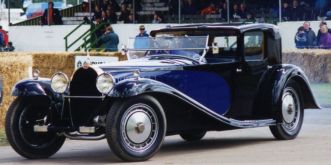 |
|
(Friday July
13th)
Glenury Royal "Rare Malts" 23y
Bugatti Royale
Type 41 |
|
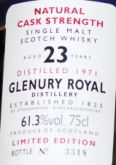 |
|
| |
The Bugatti Type 41
is more generally known as the Royale
and is rumoured to exist thanks to the comments of an English
Lady who unfavourably compared Ettore Bugatti's cars to those of
Rolls Royce. The Royale is indeed a luxury car and has a massive
4.3m wheelbase and 6.4m overall length. The Royale weighs over 3
tonnes and has a massive straight 8, 12.7 litre engine which is
one of the largest auto engines ever built producing
275 to 300 hp. Ettore Bugatti planned to sell the Royale to
European Royalty but I guess his timing was bad as this was
introduced around the time of the great European depression of
the early 30's and although he planned to build 27, only six
were ever built and only three of those actually sold.
Unbelievably, all six
production
Royales still exist today, although the prototype
(with an almost 15 litre engine) was destroyed in an accident in
1931.
Glenury Royale,
Rare Malts, 23y is also pretty large and imposing with a
nose not quite as large as the Bugatti, but comprising lots of
perfumed and floral elements alongside furniture polish, creme
brulee, mocha and rich dark chocolate. The palate is
delightfully creamy with coffee and dark chocolate. An extremely
long finish just about matches the length of that incredible
Bugatti as it just goes on and on and .......
What can I possibly add here other than to say this is indeed a
very Royal(e) pairing, big, expressive and with magnificent
presence, both the Glenury and Bugatti easily earn my personal
award of Greatness with an extremely well desrved 90 points. In
fact I may even add a couple of extra points for the Royale. I
am honoured to have tasted the Royal in June 2012 and
photographed the Royale in full running glory at Goodwood
Festival of Speed some 12-15 years ago.
|
|
| |
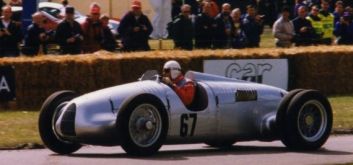 |
|
(Wednesday July
18th)
Ardbeg "Day"
Auto Union Type
C/D |
|
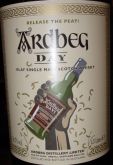 |
|
| |
The Auto Union V16
Type C
was
built as a Grand Prix racing car for the 1934-7 seasons when the
weight restriction for cars was limited to 750kg. Amazingly the
Type C had a V16 engine which produced 550 almost uncontrollable
HP. For the 1938 season the engines were restricted to 3 litres
for blown versions or 4.5 litres for conventional ones, so the
Type D 3 litre V12 was developed with almost 300 BHP. This V12
had two cylinder blocks angled at 45° with a single overhead
camshaft operating all 32 valves and providing optimum torque at
low engine speeds. The version in my photo is a special
Hillclimb model which was designed with dual back wheels to
provide more traction especially upon exiting corners.
Every year
during Feis Ile (Islay's festival of whisky and music) each
of the island's distilleries hosts an open day and in 2012
Ardbeg's open day was June 2nd. To coincide with this, Ardbeg
produced two versions of a bottling called Ardbeg "Day" which
were supplied to their "Embassies" around the world, well,
mostly in Europe really. This was available to buy in 70cl
version and for tasting(s) in the 4.5 litre version. I was
recently lucky to try this at Royal Mile Whiskies in Edinburgh.
This is a truly amazing whisky with not only that trademark
Ardbeg peatiness, but it's a massive fruit bomb too as it offers
apricot, peach and a host of summer berries on both nose and
palate. Add just 4 drops of water and the fruitiness recedes to
leave even more of that peatiness.
Whether in V16 or V12 format the Auto Union was a hard beast to
tame and although the Ardbeg comes in an equally bestial 4.5
litre version, the fruitiness really shines through and goes a
long way towards making this a very civilised dram with a
wonderful depth of flavour. What can I say other than both are
almost "Great", but just not quite as I offer a very creditable
88 points to each.
|
|
| |
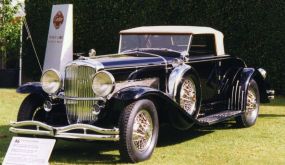 |
|
(Saturday
July
21st))
Linlithgow 1973-2004 30y
Duesenberg SJ
Roadster 1935 |
|
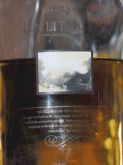 |
|
| |
Frederick & August
Duesenberg
founded Duesenberg Automobile & Motors Company Inc. in 1913 with
the intention to build sports cars and operated between 1913 and
1937. As early as 1914, just one year into the company's history
a Duesenberg finished in 10th place at the Indy 500. Duesenbergs
then went on to win the event in 1924, 1925 & 1927. In fact in
1923 Duesenbergs were used as pace cars for the race. In 1921
Jimmy Murphy became the first American to win the French Grand
Prix when he drove a Duesenberg to victory at the Le Mans
racetrack.
Pictured here is
the Duesenberg SJ Roadster from 1935 A supercharged version
reputed to do 104 mph in second gear and have a top speed of
135-140 mph in third gear. It could manage 0-60 mph in around 8
seconds and 0-100 mph in 17 seconds which is quite incredible
considering it werighed in at two and a half to three tonnes.
The supercharged engine produced 320 hp and even recorded a
1-hour average speed of 152 mph on the Bonneville Salt Flats,
Utah.
Linlithgow
1973-2004 30y Decanter is a truly magnificent whisky with
lots of delightful flora and exotic fruitiness, gentle wood, vanilla and just a
hint of furniture polish, all delivered with a wonderfully
creamy mouth-feel. Sadly the St. Magdalene distillery was closed
in 1983 and expressions of St. Magdalene and Linlithgow are
becoming harder to find, but if
you do find a well-aged one my
recommendation is to buy and savour it.
Today
I offer two pedigrees par excellence with a motoring legend and
a whisky to match. Only 36 examples of the "Duesy" SJ Roadster
are said to have been built, slightly more of this 30y
Linlithgow were bottled (or should that be decantered?) and both
are well-deserving of my personal label of "Great"ness with an
indubitable 91 points.
|
|
| |
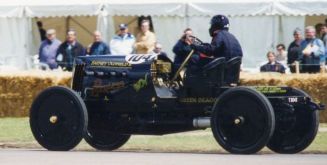 |
|
(Monday
July
23rd))
Canadian Club 1909
Peerless Green
Dragon 1904 |
|
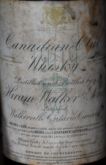 |
|
| |
The Peerless Green
Dragon was built for Barney Oldfield in 1904 after
he fell out with Alexander Winton (of Winton Motor Carriage
Company). He joined the Peerless racing team and in 1906
purchased the equipment and continued to race Peerless Green
Dragons on his own until 1907, winning many races and setting
new speed records.
Barney Oldfield
was a real crowd-pleaser with his style of driving which was
to skid around corners with full throttle, although many would
initially consider him reckless, he always received rapturous
welcomes. On December 17th, 1904, he set a new record at
Agricultural Park Los Angeles by covering a mile in 54 seconds.
Remember, this was 1904.
This Canadian
Club was distilled in 1904 and probably bottled at around
5-6 years old. I had the very rare privilege to try it during
our Malt Maniacs 15y Anniversary in Scotland thanks to fellow
Malt Maniac Patrick. It's a delightfully smooth whisky with lots
of butterscotch and nuttiness (hazelnut and almond) alongside
hints of apricot jam. It's an absolute delight and I really
couldn't help comparing it to one of today's very fine old
Scotch grain whiskies, in fact if I were to taste it totally
blind I would probably believe it to be so.
I searched my picture libraries long and hard before finding a
suitable companion to this rare old Canadian Club. In the end
there was only one real option; The 1904 Peerless Green Dragon.
It's believed that maybe as few as only four Green Dragons were
ever made and one was destroyed in August 1904 when Barney's
racing goggles were shattered by a rock, causing him to career
off the track. Only 5 years separate the creation of these two
beauties and although it's not known how many bottles of this
1904 Canadian Club were released, not how many have survived
until today, I can certainly vouch for this particular one which
was thoroughly enjoyed in June 2012. A veritable 89 points from
me.
|
|
| |
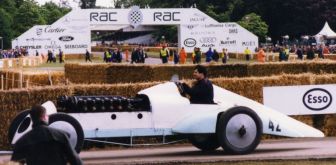 |
|
(Tuesday
July
24th))
Charbay
12y "LAWS"
Babs 1926 |
|
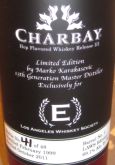 |
|
| |
How do you make a
car go faster?
These days we talk of turbo chargers, computer chips and various
other hi-tech performance enhancers, but there was a time when
one just built or installed a bigger engine. Maybe even a 27
litre aero engine.
Welcome to the
roaring twenties & "Babs" a one-off monster, a veritable
beast if I may so say. Most of my generation grew up with a
certain film called chitty chitty bang bang, now welcome to the
original Chitty 4, one of a series of aero-engined
cars Count Louis Zborowski had built in his Chitty Bang
Bang series. It was built on his Higham Park Estate near
to Canterbury, England and sported a 27 litre, V12 Liberty (aero)
engine with 450 bhp in 1924.
Sadly The Count
died before the car was fully completed and was bought for
£125 by John Parry-Thomas who
rebuilt the engine with four Zenith carburettors and his own
design of pistons. He also renamed the car "Babs" and in 1926
used it to claim a new land speed record at 171.02 mph (273.6
km/h).
On
March 3rd 1927 he was attempting another
new land speed record at
Pendine Sands when the exposed drive chain broke and is said to
have at least partially decapitated him, although there is some
doubt as to whether he was really decapitated and whether the
chain was at fault. Investigation of the recovered wreckage
suggests the right rear wheel may have failed and overturned the
car at speed.
Babs
was left buried where it crashed on the beach at Pendine for
40 years before Owen Wyn Owen excavated, recovered and began
to restore Babs. A project which would take some years. Although it wasn't firing on all
cylinders that weekend, I was fortunate to witness it running up
Goodwood hill during 1997's Festival of Speed and yes, it is a
veritable beast which growls vociferously with all 27 litres.
Charbay is a winery and distillery in Northern California
whose eccentric owner Miles Karakasevic creates occasional
whiskey editions. In his search for ultimate quality he distils
only bottle ready beers and, in this case he used Pilsner from
the (now closed) Sonoma Mountain Brewery. It's massive, it's
explosive and sports a lightly perfumed, very aromatic and truly
wonderful nose of butterscotch, apricot, exotic spices and a
touch of furniture polish. The palate delivers equally
explosively with oil of orange, finest dark chocolate espresso
coffee and various herbs and spices.
Today is
undoubtedly a day of superlatives, a feast for all the senses
with a pair of untamed beasts roaring with all their might. Babs
is big and powerful but equally matched by this quite
unbelievable Charbay. Speechless? Lost for words? maybe, but one
immediately comes to mind; "Great" which in this case means 91
points from me.
A 3-litre
dilemma: Whilst looking through my photo
libraries searching for the right partner for today's Charbay I
met upon something of a dilemma in the form of Babs or the
equally astounding 24 litre Napier-Railton Special. The
Napier-Railton was built in 1933 and soprts a 24 litre aero
engine, producing just over 500 bhp and capable of 168 mph (270
km/h). Between 1933 and 1937 this car broke 47 world speed
records.
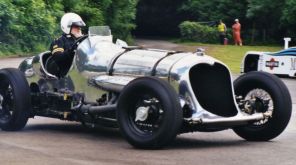

So, what are 3
litres between friends?
As a final thought for today I can't help
thinking about the difference between these two beasts, namely 3
litres. I personally drive an Alfa Romeo with a V6, 3-litre
engine and am now thinking that my own car with (almost) 230 bhp
which is capable of around 160 mph (260 km/h) is merely the
difference in capacity between these two beasts, but there
is an engine technology difference of a good 70 years and I do
manage more than 5 mles per gallon of petrol.
Slàinte
Mhath |
|
| |
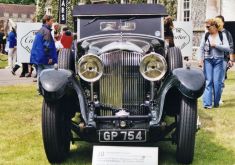 |
|
(Monday
July
30th))
Glenfarclas 1953, 58y
Bentley 8 litre
Tourer, 1931 |
|
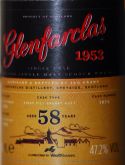 |
|
| |
The
Bentley 8 litre Tourer
has the reputation of being the largest and most luxurious
Bentley model to be built before the company collapsed and was
sold to Rolls Royce in late 1931. The model was originally
introduced in 1930 with a straight six, 8 litre engine and a
choice of 3.6 metre or 3.9 metre wheelbase, making it the largest
car built in the UK up to that time.
Only
100 examples of the Bentley 8 litre were produced as this
model was introduced at the beginning of the great depression in
Europe and sadly it failed to sell in the required numbers to
make a profit and helped put Bentley into receivership late in
1931.
Of
the 100 examples produced, many of them still exist today
and I was delighted to see this one in exemplary condition and
being shown in the Cartier competiton at Goodwood around 1997.
This
Glenfarclas 1953, 58y is an exclusive edition to Master of
Malt and is bottled in conjnction with Wealth Solutions which
means it is being promoted as an investment. It is of the oldest
vintage Glenfarclas have in their warehouse and was bottled at a
cask strength of 47.2% abv and 58 years old.
But
what about the whisky? How can any 58y whisky be so gentle,
delicate and yet so intense with flavours? It' an absolute
delight with a nose including perfumed creamy toffee, sauteed
raisins and apple, apricot fruitiness and an ancient wax seal on
parchment. The palate is equally delightful and slightly dry
with creeamy toffee sertved on a bed of Alpine flora and creamy
vanilla leading into the extremely long finish.
What
better way to end this "Classics" series than on a complete high
with two magnificent and majestic marques, in fact true "Greats"
by a country mile. You know by now what that means; 90+ points
and in this case an extremely well-deserved 94 points from me
and the honour of being the best whsiky I've yet tried in 2012.
|
|
| |
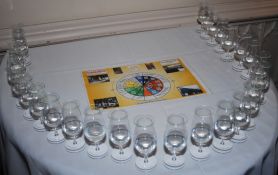 |
|
Sonntag, 1. Juli 2012
Nosing den New Make
oder "28 New Spirits in einem uralten Schloss" |
|
| |
Eines der Highlights
unserer Maniac-Events in Schottland war zweifellos ein Besuch in
den Diageo Laboratorien für Qualitätskontrolle, wo der Spirit
aus jeder der 28 Destillerien laufend analysiert wird, Batch für
Batch.
Teams von Nosing-Könnern und Spezialisten
haben die Aufgabe, laufend die New Spirits von allen 28
Destillerien zu prüfen, um deren gleichbleibende Qualität
sicherzustellen. Es gab unglaublich viel Interessantes zu sehen,
zu hören und zu riechen – eine Station unserer Führung brachte
uns in das Hirn der Anlage: wir waren dort stets umgeben von
hochwissenschaftlichen und sehr empfindlichen Maschinen, die
unablässig „blubbernd“ und „surrend“ ihren Aufgaben nachgingen.
Ich war sehr beeindruckt, kann aber hier zu meinem Leidwesen nur
diese unzureichend wissenschaftliche Beschreibung abgeben.
|
|
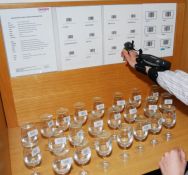 |
|
| |
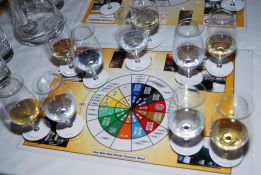 |
|
Würden unsere Maniac-Nasen
hier also Ähnlichkeiten zwischen den New Makes und den
entsprechenden, gereiften Whiskys ausmachen können? Eine
wirklich interessante Aufgabe.
Aufgereiht vor uns waren 5 Proben des New Make
und 5 Proben ausgereiften Whiskys derselben 5 Destillerien. Es
handelte sich nicht um einen Blindtest, es war aber tatsächlich
sehr interessant, einen solchen Vergleich anzustellen.
|
|
| |
Linkwood
Der New Make legt eine reichhaltig getreidige Note an den Tag,
Aromen von frischem Brotteig, von Hefe. Nach einigen
Augenblicken kommt noch ein Hauch von Himbeeren dazu. Der
gereifte Whisky hat einen sehr frischen Charakter und scheint
die Hefe- und Brotteignoten zur Gänze verloren zu haben, erfreut
dagegen durch viel Fruchtaroma, den Duft von Zitrusfrüchten.
Clynelish
Dies ist ein sehr wächserner, beinahe seifiger New Make mit
einem dezent ledrigen Anklang an Autopolitur und dem Geruch von
eingekochtem Pflaumenmus. Der Whisky selbst hat noch immer etwas
von dem Pflaumenaroma, begleitet von einer sehr undeutlichen,
wohl wächsernen Grasigkeit, ist tatsächlich aber bereits viel
runder und reifer.
Cragganmore
Es ist kaum zu glauben, aber der New Make erweckt die Vorstellung
von Schweinebraten mit Kräuterkruste; da ist aber auch einen
Hauch von Schwefel. Im gereiften Whisky gibt es keinerlei
Schwefelanklänge mehr, das Aroma von Schweinebraten jedoch ist
noch immer vorhanden. Darüber hinaus ist da noch eine würzige
Zitrusnote, Zitrone oder vielleicht Limette.
Inchgower
Hier ist nun wirklich eine meiner Lieblingsdestillerien,
besonders wenn es sich um die (viel) älteren Whisky-Semester
handelt. Wie aber verhält es sich mit dem New Make? Nun, da
gibt es viele getrocknete Walnüsse, Butterkekse und
Frühstücksflocken. Dies ist auch im reifen Whisky noch gut
wahrnehmbar, er entwickelt reichlig fruchtige und nussige Düfte
rund ums Frühstück
Caol Ila Ahh, dieser New Make ist wirklich eine Pracht – sehr gewichtig,
mit Teerseife, Rauch von Lagerfeuern und sehr viel Präsenz. Der
gereifte Whisky ist dagegen viel gelassener, stiller, was
vielleicht zu erwarten war. Da ist weniger Rauchigkeit, dafür
ein filigraner Hauch Torf und enorm viel grasige Fruchtigkeit.
Es war ein ganz wunderbarer und äußerst interessanter Exkurs, den
New Make direkt mit seinen gereiften Counterparts vergleichen zu
können. Ich konnte mein Wissen über den Whisky um Einiges
erweitern, war jedoch außerstande, die schwindelnden Höhen der
Wissenschaft zu erklimmen, um hinter das Geheimnis dieser
blubbernden und surrenden Hi-Tech-Maschinen zu kommen.
Slàinte Mhath |
|
|
Monat |
Kürzlich behandelte Themen
(Eine
vollständige Liste von allen unter Dram-atics veröffentlichten
Artikeln sind in meiner Inhaltsangabe nachzulesen.) |
|
   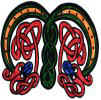     
© Copyright
2009-2012 by Keith Wood - All rights reserved - Whisky-Emporium |
 |
